
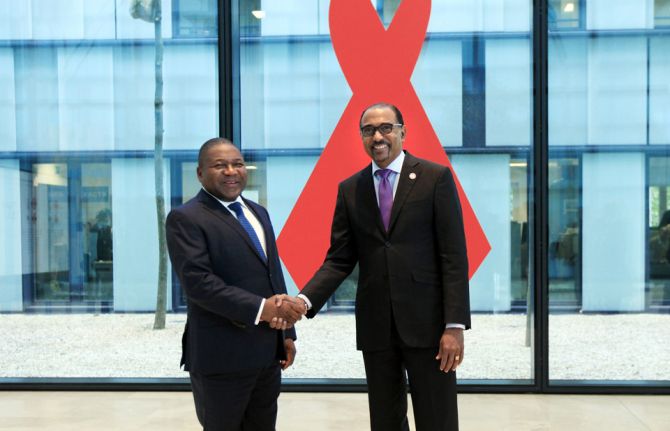
Press Release
President of Mozambique visits UNAIDS to discuss global health
27 February 2018 27 February 2018GENEVA, 27 February 2018—UNAIDS has received its first presidential visit. The President of Mozambique, Filipe Nyusi, visited UNAIDS headquarters in Geneva, Switzerland, on 27 February 2018 to discuss the response to HIV, tuberculosis and malaria with Geneva-based global health leaders.
The President met the Executive Director of UNAIDS, Michel Sidibé, and thanked him for UNAIDS’ continued support to Mozambique in its efforts to reduce new HIV infections, expand access to antiretroviral therapy and break down the stigma and discrimination surrounding HIV.
“UNAIDS is so important to the lives of people, because in Mozambique there is nothing more important than life itself,” said Mr Nyusi. “Everything we do can only be done if we are healthy. So as leaders we need to ensure our people’s well-being.”
Mr Sidibé highlighted that since 2000, Mozambique has quadrupled the number of people on antiretroviral therapy, reduced the number of new HIV infections among children by 63% and ensured that 80% of pregnant women living with HIV have access to treatment, which he called “a remarkable achievement”.
“The President of Mozambique is a true example of the new era of leadership in Africa, which is improving health outcomes for people across the continent,” said Mr Sidibé.
The President participated in a round-table discussion on global health and the Sustainable Development Goals, which included the Mr Sidibé, José Condugua Antonio Pacheco, Minister of Foreign Affairs and Joao Leopoldo Da Costa, Deputy Minister of Health of Mozambique, Ambassador Pedro Comissario, Permanent Representative of Mozambique in Geneva, Seth Berkley, Chief Executive Officer of Gavi The Vaccine Alliance, Kesete Admasu, Chief Executive Officer of the Roll Back Malaria Partnership and Marijke Wijnroks, Interim Executive Director of the Global Fund to Fight AIDS, Tuberculosis and Malaria
During the discussions, the President described how he is scaling up efforts in Mozambique and how the health of the people is improving. However, he also outlined the many challenges he faces, including funding to strengthen the health system, reaching remote areas in the north of Mozambique and controlling the spread of disease through Mozambique’s many ports.
The Geneva-based global health leaders recognized the challenges and encouraged him to continue working to improve health outcomes for the people of Mozambique, pledging their full support. They also urged him to continue his work in increasing the number of community health workers in order to alleviate some of the burden on the overstretched health system and reach more people in rural communities.
UNAIDS
The Joint United Nations Programme on HIV/AIDS (UNAIDS) leads and inspires the world to achieve its shared vision of zero new HIV infections, zero discrimination and zero AIDS-related deaths. UNAIDS unites the efforts of 11 UN organizations—UNHCR, UNICEF, WFP, UNDP, UNFPA, UNODC, UN Women, ILO, UNESCO, WHO and the World Bank—and works closely with global and national partners towards ending the AIDS epidemic by 2030 as part of the Sustainable Development Goals. Learn more at unaids.org and connect with us on Facebook, Twitter, Instagram and YouTube.
Press centre
Download the printable version (PDF)

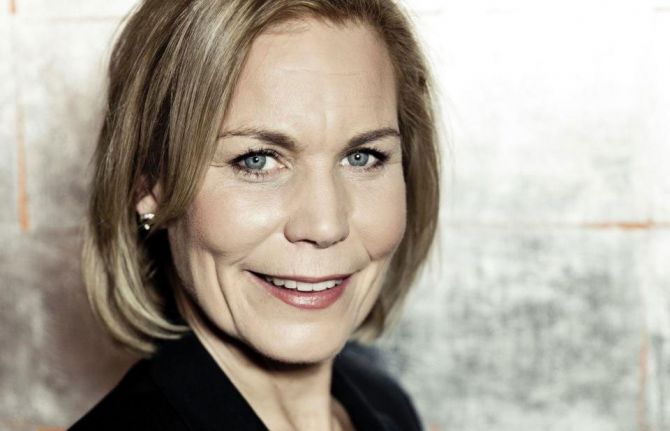
Press Release
UNAIDS welcomes Gunilla Carlsson as new Deputy Executive Director, Management and Governance
12 December 2017 12 December 2017
GENEVA, 12 December 2017—United Nations Secretary-General António Guterres has appointed Gunilla Carlsson as the new UNAIDS Deputy Executive Director, Management and Governance, and Assistant Secretary-General of the United Nations.
“Gunilla Carlsson is known for her dynamic leadership and deep knowledge of the issues,” said UNAIDS Executive Director Michel Sidibé. “She is not a business-as-usual leader. I know her innovative approach and extensive network will be critical in taking UNAIDS to the next level.”
Ms Carlsson served as an elected member of the Swedish Parliament from 2002 to 2013 and as Minister for International Development Cooperation from 2006 to 2013. She also served as an elected member of the European Parliament from 1995 to 2002.
A strong leader in global health and development, Ms Carlsson was a member of the UNAIDS and Lancet Commission: Defeating AIDS—Advancing Global Health and a member of the World Bank Gender Advisory Council and served on the United Nations High-Level Panel on the Post-2015 Development Agenda. Currently, she is a senior adviser to the African Development Bank and serves on the board of Gavi, the Vaccine Alliance, as Vice-Chair.
Ms Carlsson will assume her new role in early 2018. She succeeds Jan Beagle, who was appointed United Nations Under-Secretary-General for Management in June 2017.
“I wish to extend my sincere appreciation to Joel Rehnstrom for serving UNAIDS as Acting Deputy Executive Director,” added Mr Sidibé.
UNAIDS
The Joint United Nations Programme on HIV/AIDS (UNAIDS) leads and inspires the world to achieve its shared vision of zero new HIV infections, zero discrimination and zero AIDS-related deaths. UNAIDS unites the efforts of 11 UN organizations—UNHCR, UNICEF, WFP, UNDP, UNFPA, UNODC, UN Women, ILO, UNESCO, WHO and the World Bank—and works closely with global and national partners towards ending the AIDS epidemic by 2030 as part of the Sustainable Development Goals. Learn more at unaids.org and connect with us on Facebook, Twitter, Instagram and YouTube.
Press centre
Download the printable version (PDF)

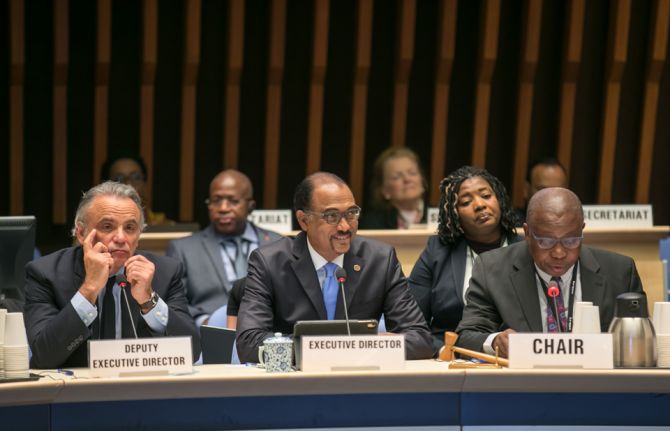
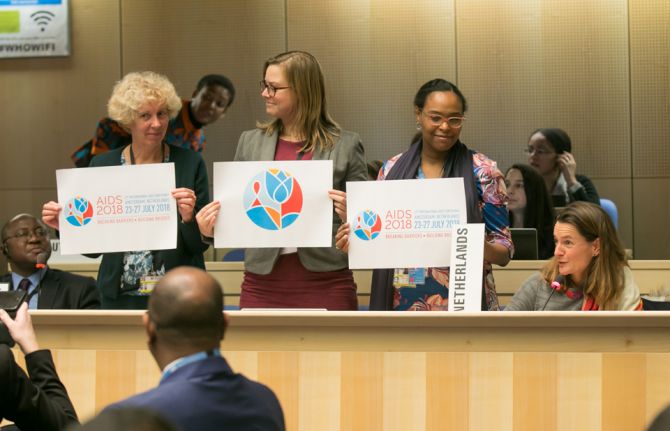

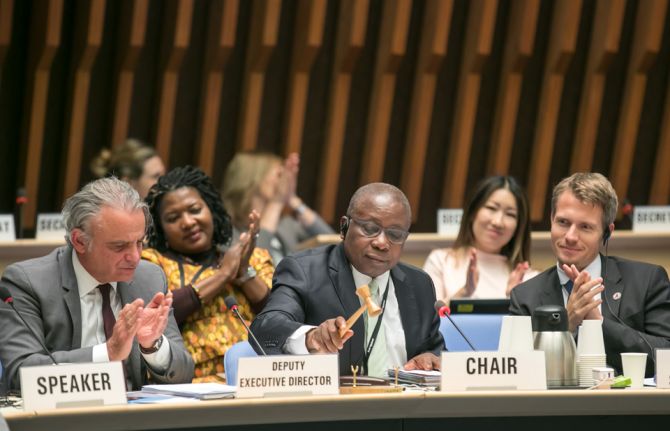
Press Release
Board recognizes progress made by UNAIDS as an example of United Nations reform in action
15 December 2017 15 December 2017GENEVA, 15 December 2017—The 41st UNAIDS Programme Coordinating Board meeting concluded in Geneva, Switzerland, on 14 December. The Board took note of the report on progress in implementing the UNAIDS Joint Programme Action Plan and the Strategic Resource Mobilization Plan 2018–2021 and called for additional contributions towards fully funding UNAIDS’ core Budget, Results and Accountability Framework.
The Board recognized the significant progress achieved by UNAIDS over the past months as an example of United Nations reform in action. The Board members welcomed the strengthened partnership with the Global Fund to Fight AIDS, Tuberculosis and Malaria and expressed a shared sense of urgency to Fast-Track resource mobilization to effectively implement programmes.
The Executive Director of UNAIDS, Michel Sidibé, presented his report to the Board in the opening session, in which he highlighted the significant progress that has been achieved in access to antiretroviral therapy and in stopping new HIV infections among children.
Mr Sidibé also highlighted the need to do more to reach the people being left behind, including young women and adolescent girls, and to address the blind spot in engaging men. He emphasized that stigma, discrimination and criminalization must be confronted head on, as central to achieving UNAIDS’ vision for health and the Sustainable Development Goals. “We will not realize the right to health for all if we do not confront and eliminate stigma and discrimination,” he said. “The Sustainable Development Goals demand that we tackle health and development differently. UNAIDS continues to be a leader on this front.”
The Board noted the reinvigorated commitment to HIV prevention and reaffirmed the need to redouble the commitment to it, including through ensuring a quarter of funding for HIV prevention.
During the final day of the meeting, which was dedicated to a thematic session on discrimination in health-care settings, members of the Board gave their commitment to continue working to end stigma and discrimination. The nongovernmental organization delegation called for a global compact to eliminate all forms of stigma and discrimination.
The members of the Board reflected on the growing HIV and related health and human rights challenges in prisons and other closed settings. They shared examples of action being taken in their respective countries, while acknowledging the need to do more.
Argentina, Côte d’Ivoire and Ghana were recognized for their recent financial contributions to UNAIDS, and China, Denmark, Germany, Poland and Sweden were recognized for their increased financial support.
An address made by Ruth Dreifuss, former President of Switzerland and current Chair of the Global Commission on Drug Policy, recognized the important role that UNAIDS has played in advocating for evidence-informed, human rights-based responses to HIV, including in the context of drug use.
Representatives of United Nations Member States, international organizations, civil society and nongovernmental organizations attended the three-day meeting, held from 12 to 14 December, which was chaired by the Minister of Health of Ghana, Kwaku Agyemang-Manu, with the United Kingdom of Great Britain and Northern Ireland serving as Vice-Chair and Japan as Rapporteur.
The UNAIDS Executive Director’s report to the Board and the Board’s decisions can be found at unaids.org.
UNAIDS
The Joint United Nations Programme on HIV/AIDS (UNAIDS) leads and inspires the world to achieve its shared vision of zero new HIV infections, zero discrimination and zero AIDS-related deaths. UNAIDS unites the efforts of 11 UN organizations—UNHCR, UNICEF, WFP, UNDP, UNFPA, UNODC, UN Women, ILO, UNESCO, WHO and the World Bank—and works closely with global and national partners towards ending the AIDS epidemic by 2030 as part of the Sustainable Development Goals. Learn more at unaids.org and connect with us on Facebook, Twitter, Instagram and YouTube.
Contact
UNAIDS GenevaSophie Barton-Knott
tel. +41 79 514 6896
bartonknotts@unaids.org
UNAIDS Communications
tel. +41 22 791 3873
communications@unaids.org
Press centre
Download the printable version (PDF)

Press Release
UNAIDS and IOM renew partnership agreement to promote access to HIV services for migrants and crisis-affected populations
08 December 2017 08 December 2017GENEVA, 8 December 2017—UNAIDS and the International Organization for Migration (IOM) today signed a new cooperation agreement to promote access to HIV prevention, treatment, care and support services for migrants, mobile populations and people affected by humanitarian emergencies.
“Migrants and people displaced through conflict or emergencies must be supported and enabled through their journeys to exercise their right to health,” said Michel Sidibé, Executive Director of UNAIDS. “This new partnership agreement between UNAIDS and the International Organization for Migration will be essential in strengthening our efforts to make sure that no one is left behind.”
Under the new agreement, UNAIDS and IOM will encourage states to take steps to ensure access to HIV prevention, treatment, care and support and to reduce stigma, discrimination and violence. States will also be encouraged to review policies related to restrictions on entry based on HIV status, with a view to eliminating such restrictions.
“Migrants and mobile populations are exposed to a unique set of factors that render them more vulnerable to HIV, including limited access to health services and information as well as exposure to environments that are conducive to engaging in higher-risk behaviours,” said IOM Director General William Lacy Swing. “In order to achieve the Sustainable Development Goals and to meet the universal health coverage targets set therein, it is crucial that the rights of migrants to health be realized and effected through evidence-based, whole-of-government and cross-sector approaches, and the International Organization for Migration will continue to work closely with UNAIDS and other actors in jointly addressing these issues,” added Mr Swing.
IOM and UNAIDS will work to ensure a package of care for people living with HIV and/or tuberculosis in humanitarian emergencies and conflict settings to reduce their vulnerability to HIV, reduce the risk of treatment interruption and ensure access to quality healthcare and nutritious food.
UNAIDS and IOM will also tackle the multiple forms of discrimination against refugee and migrant women and girls and promote access to tailored comprehensive HIV prevention services for women and adolescent girls, migrants and key populations.
IOM and UNAIDS have a long-standing partnership. IOM is part of the United Nations joint teams on HIV at the country level and its HIV and population mobility programme complements the work of UNAIDS globally.
During the 108th session of the IOM Council, UNAIDS was granted observer status by IOM, a sign of strengthened cooperation between the two institutions.
UNAIDS
The Joint United Nations Programme on HIV/AIDS (UNAIDS) leads and inspires the world to achieve its shared vision of zero new HIV infections, zero discrimination and zero AIDS-related deaths. UNAIDS unites the efforts of 11 UN organizations—UNHCR, UNICEF, WFP, UNDP, UNFPA, UNODC, UN Women, ILO, UNESCO, WHO and the World Bank—and works closely with global and national partners towards ending the AIDS epidemic by 2030 as part of the Sustainable Development Goals. Learn more at unaids.org and connect with us on Facebook, Twitter, Instagram and YouTube.
IOM
Established in 1951, IOM is the leading inter-governmental organization in the field of migration and works closely with governmental, intergovernmental and non-governmental partners. With 169 member states, a further 9 states holding observer status and offices in over 100 countries, IOM is dedicated to promoting humane and orderly migration for the benefit of all. It does so by providing services and advice to governments and migrants.
Contact
UNAIDSSophie Barton-Knott
tel. +41 22 791 1697
bartonknotts@unaids.org
IOM
Jorge Galindo
tel. +41 22 717 9205
jgalindo@iom.int
Press centre
Download the printable version (PDF)



Press Release
Naomi Campbell, Marc Jacobs and UNAIDS announce collaboration on limited edition T-shirt for World AIDS Day
01 December 2017 01 December 2017GENEVA, 1 December 2017—The celebrated fashion designer Marc Jacobs has designed a limited edition T-shirt to raise funds for UNAIDS’ activities in support of people around the world living with or affected by HIV. The T-shirt will retail for US$ 55 and is on sale at marcjacobs.com.
The T-shirt chimes with the theme of this World AIDS Day campaign, #myrighttohealth. Everyone, regardless of who they are or where they live, has a right to health.
Actress, model and activist Naomi Campbell came up with the initial idea for the collaboration.
“It felt only right to collaborate with Marc Jacobs,” said Ms Campbell. “Given his understanding of the global HIV epidemic and the many friends we have lost to the disease, there’s no one I’d rather work with to continue bringing awareness to UNAIDS.”
UNAIDS is excited to work with Ms Campbell and Mr Jacobs, who are both long-standing advocates for an AIDS response that leaves no one behind. The collaboration has been coordinated by the CAA Foundation, the philanthropic arm of Creative Artists Agency (CAA), which represents Ms Campbell.
“Naomi Campbell’s long history of commitment to humanitarianism is both remarkably commendable and genuine,” said Mr Jacobs. “I was honoured to be asked by her to collaborate on this T-shirt in support of UNAIDS as a continued effort to raise awareness for this globally important cause.”
Ms Campbell and Mr Jacobs particularly want to raise awareness about the vulnerability of young people to HIV. There were an estimated 610 000 new HIV infections among young people aged 15 to 24 years in 2016, with young women accounting for 59% of new infections among that age group. In eastern and southern Africa, young women aged 15 to 24 years make up two thirds of new HIV infections among that age group.
“Young women face many challenges as they transition into adulthood and the rules are often stacked against them,” said UNAIDS Executive Director Michel Sidibé. “This special T-shirt will help UNAIDS continue our work to level the playing field and advance young women to make independent and life-changing decisions and assert their right to health.”
Gender inequalities, including gender-based violence, exacerbate the vulnerability of women and girls to HIV and block their access to HIV services. Young people are often denied the information and freedom they need to make free and informed decisions about their sexual health, with most lacking the knowledge required to protect themselves from HIV. Research also shows the importance of keeping girls in school for as long as possible, since young women who have no formal education are twice as likely to become infected with HIV as young women who have had some schooling.
UNAIDS
The Joint United Nations Programme on HIV/AIDS (UNAIDS) leads and inspires the world to achieve its shared vision of zero new HIV infections, zero discrimination and zero AIDS-related deaths. UNAIDS unites the efforts of 11 UN organizations—UNHCR, UNICEF, WFP, UNDP, UNFPA, UNODC, UN Women, ILO, UNESCO, WHO and the World Bank—and works closely with global and national partners towards ending the AIDS epidemic by 2030 as part of the Sustainable Development Goals. Learn more at unaids.org and connect with us on Facebook, Twitter, Instagram and YouTube.
Press centre
Download the printable version (PDF)

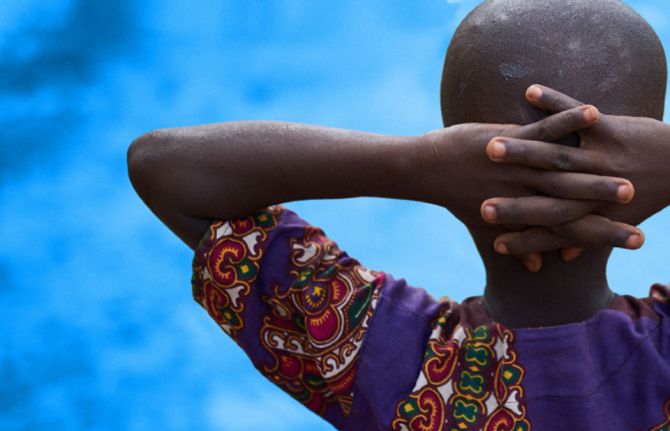
Press Release
West and Central Africa left behind in global HIV response
05 December 2017 05 December 2017New report highlights urgent need for an improved HIV response for children and adolescents
ABIDJAN/DAKAR/NEW YORK/GENEVA, 5 December 2017 – More than four decades into the HIV epidemic, four in five children living with HIV in West and Central Africa are still not receiving life-saving antiretroviral therapy, and AIDS-related deaths among adolescents aged 15-19 are on the rise, according to a new report released today.
While acknowledging progress in several areas, the report Step Up the Pace: Towards an AIDS-free generation in West and Central Africa, jointly published by UNICEF and UNAIDS, shows that West and Central Africa is lagging behind on nearly every measure of HIV prevention, treatment and care programmes for children and adolescents. In 2016, an estimated 60,000 children were newly infected with HIV in West and Central Africa.
“It is tragic that so many children and adolescents today are not receiving the treatment they need just because they have not been tested,” said Marie-Pierre Poirier, UNICEF’s West and Central Africa Regional Director. “We need to make better use of innovations to increase early diagnosis and improve access to HIV treatment and care for children. For example, the point-of-care technology diagnostic brings testing closer to where children attend health services and self-testing can be a good option for adolescents who may be more comfortable with it.”
The region’s coverage of life-saving antiretroviral therapy among children living with HIV is the lowest in the world because many countries have limited capacity to perform the tests needed for early infant diagnosis of HIV. Without knowing a child’s HIV status, his or her family is less likely to seek the treatment that could prevent the tragedy of a child’s death from AIDS-related illnesses.
The situation is worse among adolescents. The annual number of new HIV infections among those aged 15–19 years in the region now exceeds that of children aged 0-14 years. These new infections occur mostly through unprotected sexual contact and among adolescent girls. Equally concerning, according to the report, is that West and Central Africa has recorded a 35 per cent increase in the annual number of AIDS-related deaths among adolescents aged 15-19 years — the only age group in which the number of AIDS-related deaths increased between 2010 and 2016.
With the region’s youth population expected to grow significantly within the coming decades, especially in countries like the Democratic Republic of the Congo and Nigeria, the numbers of children and adolescents becoming infected with HIV and dying from AIDS is likely to remain high, unless the HIV response – both prevention and treatment – improves dramatically.
The report highlights that the 24 countries that make up the West and Central Africa region are home to 25 per cent of children aged 0–14 years living with HIV worldwide.
“Leaders of the region have endorsed a Catch-Up plan aiming to triple the number of people on treatment in the region – including children – by the end of 2018, the key issue now is to accelerate implementation,” said Luiz Loures, UNAIDS Deputy Executive Director. “Countries should urgently put in place more effective strategies for early infant diagnosis of HIV, and start reducing inequity in children’s access to treatment.”
The report proposes key strategies that will enable countries to accelerate progress in curbing the spread of disease. These include:
- A differentiated HIV response focusing on unique epidemiological and local contexts in each country and community.
- The integration of HIV services into key social services including health, education and protection.
- Community ownership and local governance of the HIV response including working with families, better placed to help reduce stigma, access prevention and treatment.
- Investment in innovations to remove barriers to scale-up including new diagnostic and biomedical approaches such as point of care diagnostics, HIV self-testing and pre-exposure prophylaxis.
UNICEF announced last week that at the current pace of progress, the global 2020 Super-Fast-Track targets to end AIDS among children will not be achieved.
***
Key facts from the report:
- Prevention of mother-to-child transmission of HIV coverage has increased 2.5-fold between 2010 and 2016 (from 21 per cent to 49 per cent), with some countries such as Benin, Burkina Faso and Cabo Verde now providing these services to more than 80 per cent of the pregnant women living with HIV.
- West and Central Africa has the lowest paediatric antiretroviral treatment coverage in the world, with only 21 per cent of the 540,000 children (0-14) living with HIV receiving antiretroviral treatment in 2016 – compared to 43 per cent globally.
- Today, West and Central Africa accounts for 37 per cent of the world’s AIDS-related deaths among children: about 43,000 AIDS-related deaths occurred among children in West and Central Africa in 2016, a decrease of 31 per cent compared to 2010.
- There were 62,000 adolescents (15-19) newly infected with HIV in 2016, unchanged compared to 2010.
- Adolescent girls and young women continue to be the most affected, with women making up nearly three out of five of all adolescents aged 10-19 years living with HIV across West and Central Africa.
Note to editors:
The Report is available at: https://www.unicef.org/publications/index_101480.html
More information is available at: www.childrenandaids.org
About UNICEF
UNICEF works in some of the world’s toughest places, to reach the world’s most disadvantaged children. Across 190 countries and territories, we work for every child, everywhere, to build a better world for everyone. For more information about UNICEF and its work for children, visit www.unicef.org
About UNAIDS
The Joint United Nations Programme on HIV/AIDS (UNAIDS) leads and inspires the world to achieve its shared vision of zero new HIV infections, zero discrimination and zero AIDS-related deaths. UNAIDS unites the efforts of 11 UN organizations—UNHCR, UNICEF, WFP, UNDP, UNFPA, UNODC, UN Women, ILO, UNESCO, WHO and the World Bank—and works closely with global and national partners towards ending the AIDS epidemic by 2030 as part of the Sustainable Development Goals. Learn more at unaids.org and connect with us on Facebook, Twitter, Instagram and YouTube. For more information about UNAIDS and its work, visit www.unaids.org
Contact
UNICEF West and Central Africa (at ICASA)Anne-Isabelle Leclercq Balde
tel. +221 77 740 69 14
aleclercqbalde@unicef.org
Gbolayemi Lufadeju
UNICEF New York
tel. +1 917 213 4034
glufadeju@unicef.org
Aminata Ouattara
UNAIDS (at ICASA)
tel. +221 77 498 1753
ouattaraa@unaids.org
Charlotte Sector
UNAIDS (at ICASA)
tel. +41 79 500 8617
sectorc@unaids.org
Resources
Press centre
Download the printable version (PDF)

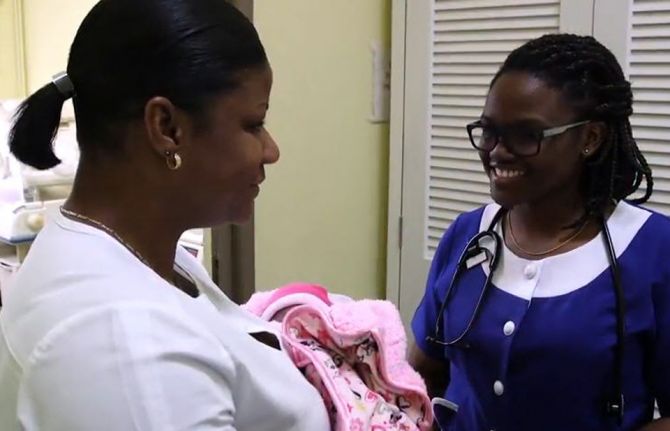
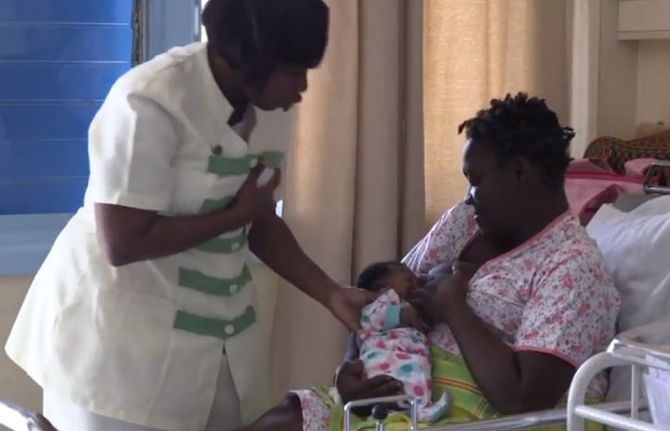
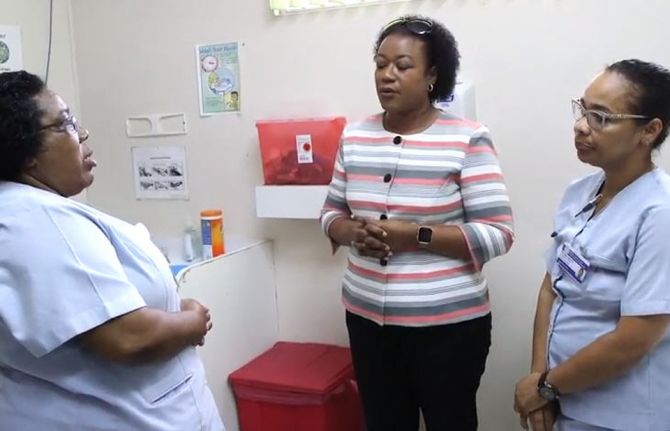
Press Release
Six Caribbean territories and states eliminate mother-to-child transmission of HIV and syphilis
01 December 2017 01 December 2017The World Health Organization has validated Anguilla, Antigua and Barbuda, Bermuda, Cayman Islands, Montserrat, and Saint Kitts and Nevis as achieving dual elimination
Saint Kitts and Nevis/ Geneva, December 1, 2017 - Anguilla, Antigua and Barbuda, Bermuda, Cayman Islands, Montserrat and Saint Kitts and Nevis were today certified by the World Health Organization (WHO) as having eliminated mother-to-child transmission of HIV and syphilis.
“This elimination is the result of our strong political commitment to public health and of making the health of mothers, children and families a regional priority,” said Timothy Harris, Prime Minister of St. Kitts and Nevis. Over the last six years the Caribbean has succeeded in reducing new HIV infections in children by more than half. “This is an amazing achievement given the high rates of HIV in the past, and we intend to improve on this success story even more in the future.”
Carissa F. Etienne, Director of the Pan American Health Organization (PAHO) and Regional Director for the Americas of WHO, said “This elimination is a remarkable achievement that puts the Americas at the forefront of the global effort to ensure that no child is born with HIV or congenital syphilis”. “With political commitment, stronger health systems, and timely prevention, diagnosis and treatment, we can achieve great changes,” she added.
“UNAIDS congratulates the six states and territories on this important achievement,” said Michel Sidibé, Executive Director of UNAIDS. “All countries should follow their example and ensure that every child has an HIV-free start to his or her life.”
In 2015, Cuba, another Caribbean island, became the first country in the world to receive validation from WHO for having achieved elimination of mother-to-child transmission of HIV and syphilis. Subsequently, Thailand and Belarus were also validated as having achieved dual elimination, while Armenia received validation of its elimination of mother-to-child transmission of HIV and the Republic of Moldova was validated for the elimination of congenital syphilis.
Since the launch in 2010 of the Regional Initiative for the Elimination of Mother-to-Child Transmission of HIV and Congenital Syphilis in Latin America and the Caribbean—coordinated by PAHO and the United Nations Children’s Fund (UNICEF), with support from other regional partners—new HIV infections have been reduced in the Caribbean by more than half among children, from 1800 in 2010 to fewer than a thousand in 2016. Reported cases of congenital syphilis, meanwhile, remain below the goal of having no more than 50 cases per 100,000 live births, although they have not declined since 2010, and it is likely there is underreporting of cases.
“The elimination of mother-to-child transmission of HIV and syphilis is not just a dream; it’s an achievable goal,” said Maria Cristina Perceval, UNICEF Regional Director for Latin America and the Caribbean. “Today we can say we are closer to ensuring an AIDS-free generation”.
In the Caribbean as of 2016, 74% of pregnant women living with HIV, 64% more than in 2010, had access to antiretroviral therapy to protect their health and significantly reduce the possibility of transmitting the virus to their children during pregnancy, delivery or breastfeeding. The increased access to treatment contributed to a 52% reduction in the rate of mother-to-child transmission of HIV between 2010 and 2016, which is now at 9%, still higher than the target of 2%.
Other changes in the health sector that have contributed to this progress include intensive participation by both the public and private health sectors, led by the ministries of health, in the implementation of comprehensive maternal and child health services, with an emphasis on universal coverage and quality antenatal and prenatal care. They also include expanded testing to ensure early detection and immediate treatment for both HIV and syphilis, laboratory networks of guaranteed quality in accordance with international standards and the implementation of essential measures to guarantee the human rights of women living with HIV.
“The validation for the elimination of mother-to-child transmission of HIV and syphilis sends a strong message that the Caribbean is making remarkable inroads to achieving the goal of an AIDS-free generation and the achievement directly aligns with achieving our vision and objectives,” said Dereck Springer, Director of the Pan Caribbean Partnership against HIV and AIDS. “The spread of the disease from mothers to children is being halted, but elimination status must be maintained and other Caribbean countries must strengthen their services with the goal of receiving validation from WHO,” he added.
The elimination of mother-to-child transmission of HIV and syphilis is an important milestone for ending AIDS and sexually transmitted infections as public health threats by 2030, commitments endorsed by the United Nations General Assembly and by the World Health Assembly. Other PAHO Member States in the Caribbean are participating in the formal validation process, and it is expected that more will be recognized for their achievements in 2018.
Spotlight on HIV prevention
This week, PAHO and UNAIDS launched their first joint report on HIV prevention in the Americas, entitled HIV Prevention in the Spotlight: A Health Sector Analysis in Latin America and the Caribbean. The report shows that the number of new HIV infections among adults remained stable in Latin America and the Caribbean between 2010 and 2016, at about 120,000 new HIV infections annually. The report urges countries to step up the implementation of a comprehensive package of interventions to prevent new HIV infections for key populations, so as to end the AIDS epidemic as a public health threat by 2030.
Among the report’s specific recommendations is expanded access to HIV self-testing and diagnosis of other sexually transmitted infections, the provision of pre- and post-exposure prophylaxis as recommended by WHO, treatment for all people living with HIV, and eliminating discrimination.
HIV and syphilis in the Caribbean in 2016*
- 310 000 [280 000–350 000] people living with HIV.
- 64% [51–74%] of people living with HIV know their status.
- 81% [64– >85%] of people diagnosed with HIV on antiretroviral therapy.
- 67% [53–77%] of people on antiretroviral therapy have a suppressed viral load.
- 18 000 [15 000–22 000] new HIV infections.
- 9400 [7300–12 000] AIDS-related deaths.
- 1.25 million live births in 2014 in 31 Caribbean countries.
- 10 000 [8700–12 000] children up to 14 years of age living with HIV, 29% less than in 2010.
- <1000 [<1000–1000] new HIV infections among children up to 14 years old in 2016, more than 52% less than in 2010.
- 11 000 [9000–13 000] new HIV infections prevented among children up to 14 years old from 2010 to 2016.
- 97% of women attend at least one antenatal check-up, and 94% of deliveries took place in hospitals in 2016.
- 78% of pregnant women were tested for HIV in 2016, 35% more than in 2010.
- 74% [65–84%] of pregnant women living with HIV are on antiretroviral therapy, a 64% increase since 2010.
- 9% rate of mother-to-child transmission of HIV, 52% less than in 2010.
- 96% coverage of testing for syphilis among pregnant women who had at least one prenatal visit, stable since 2010.
- 80% of pregnant women diagnosed with syphilis received adequate treatment, stable since 2010.
- 1 case of congenital syphilis every 10 000 live births in 2016 according to data from 21 countries, stable since 2010.
* Source: Global Monitoring of AIDS 2017, UNAIDS and data directly reported by countries to PAHO.
WHO validation process
The validation process begins with a request from a country to PAHO for the validation of the elimination of mother-to-child transmission of HIV and syphilis. Then, an independent Regional Validation Committee is formed to carry forward the process, using the global validation standards recommended by WHO.
In the case of these Caribbean states and territories, the members of the regional committee were experts from 10 countries of the Americas, who reviewed the reports of each state and carried out virtual and in situ evaluations in four key areas: health programmes and services, data and information systems, laboratory quality and human rights, gender equality and community participation.
On the recommendation of the regional committee, the Global Validation Advisory Committee conducted a second review and recommended to the Director-General of WHO the validation of Anguilla, Antigua and Barbuda, Bermuda, Cayman Islands, Montserrat and Saint Kitts and Nevis for the achievement of the elimination of mother-to-child transmission of HIV and syphilis as a public health threat.
###
The Pan American Health Organization (PAHO) works with the countries of the Americas to improve the health and quality of life of their peoples. Founded in 1902, it is the oldest international public health organization in the world. It acts as the regional office for the Americas of the WHO and is the specialized health agency of the inter-American system.
The Joint United Nations Programme on HIV/AIDS (UNAIDS) leads and inspires the world to achieve its shared vision of zero new HIV infections, zero discrimination and zero AIDS-related deaths. UNAIDS unites the efforts of 11 UN organizations—UNHCR, UNICEF, WFP, UNDP, UNFPA, UNODC, UN Women, ILO, UNESCO, WHO and the World Bank—and works closely with global and national partners towards ending the AIDS epidemic by 2030 as part of the Sustainable Development Goals. Learn more at unaids.org and connect with us on Facebook, Twitter, Instagram and YouTube.
Note to editors:
The indicators required by PAHO / WHO for validation in the Americas include:
Impact indicators—must be reached for at least two consecutive years:
- 30 cases or fewer of new perinatal HIV infections per 100,000 live births; and
- 50 cases or fewer of congenital syphilis per 100,000 live births; and
- 2% or below rate of mother-to-child transmission of HIV.
Process indicators—must be achieved for at least two consecutive years:
- 95% or more of all pregnant women should receive at least one antenatal care visit.
- 95% or more of pregnant women living with HIV tested for the virus.
- 95% or more of pregnant women attending prenatal care screened for syphilis.
- 95% or more of pregnant women diagnosed with HIV or syphilis receive adequate treatment.
The term validation is used to attest that a country has successfully achieved the indicators (regional and global targets established for validation) to eliminate mother-to-child transmission of HIV and syphilis at a specific point in time and demonstrate a health system strong enough to maintain the gains.

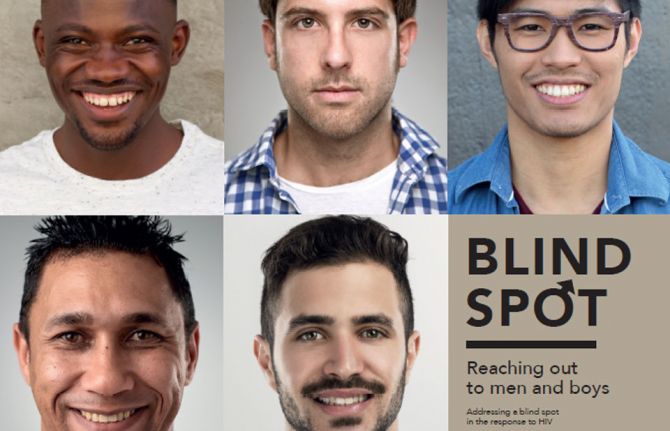
Press Release
On World AIDS Day, UNAIDS warns that men are less likely to access HIV treatment and more likely to die of AIDS-related illnesses
01 December 2017 01 December 2017New report from UNAIDS shows the blind spot in reaching men with HIV services
OTTAWA/GENEVA, 1 December 2017—On World AIDS Day, UNAIDS has released a new report showing that men are less likely to take an HIV test, less likely to access antiretroviral therapy and more likely to die of AIDS-related illnesses than women. The Blind spot shows that globally less than half of men living with HIV are on treatment, compared to 60% of women. Studies show that men are more likely than women to start treatment late, to interrupt treatment and to be lost to treatment follow-up.
“Addressing the inequalities that put women and girls at risk of HIV is at the forefront of the AIDS response,” said Michel Sidibé, Executive Director of UNAIDS. “But there is a blind spot for men—men are not using services to prevent HIV or to test for HIV and are not accessing treatment on the scale that women are.”
In sub-Saharan Africa, men and boys living with HIV are 20% less likely than women and girls living with HIV to know their HIV status, and 27% less likely to be accessing treatment. In KwaZulu-Natal, the province with the highest HIV prevalence in South Africa, only one in four men aged 20–24 years living with HIV in 2015 knew that they had the virus.
In western and central Africa, a region that is struggling to respond effectively to HIV, only 25% of men living with HIV are accessing treatment. When people are not on treatment they are more likely to transmit HIV.
“When men access HIV prevention and treatment services, there is a triple dividend,” said Mr Sidibé. “They protect themselves, they protect their sexual partners and they protect their families.”
The report highlights data from sub-Saharan Africa that show that condom use during sex with a non-regular partner is low among older men, who are also more likely to be living with HIV—50% of men aged 40–44 years and 90% of men aged 55–59 years reported not using a condom. These data are consistent with studies showing a cycle of HIV transmission from older men to younger women, and from adult women to adult men of a similar age in places with high HIV prevalence.
The Blind spot also shows that HIV prevalence is consistently higher among men within key populations. Outside of eastern and southern Africa, 60% of all new HIV infections among adults are among men. The report outlines the particular difficulties men in key populations face in accessing HIV services, including discrimination, harassment and denial of health services.
Men who have sex with men are 24 times more likely to acquire HIV than men in the general population and in over two dozen countries HIV prevalence among men who have sex with men is 15% or higher. However, recent studies suggest that condom use is dropping in Australia, Europe and the United States of America. In the United States, for example, the percentage of HIV-negative gay men and other men who have sex with men who engage in sex without using condoms increased from 35% to 41% between 2011 and 2014.
“We cannot let complacency set in,” said Mr Sidibé. “If complacency sets in, HIV will take hold and our hopes of ending AIDS by 2030 will be shattered.”
The Blind spot shows that around 80% of the 11.8 million people who inject drugs are men and that HIV prevalence among people who inject drugs exceeds 25% in several countries. Condom use is almost universally low among people who inject drugs and the percentage of men who inject drugs using sterile injecting equipment during their last drug injection varies from country to country. In Ukraine, for example, the percentage of men who inject drugs who used a sterile needle at last injection was well over 90%, whereas in the United States only around 35% used a sterile needle.
In prisons, where 90% of detainees are men, HIV prevalence is estimated at between 3% and 8%, yet condoms and harm reduction services are rarely made available to detainees.
While HIV testing has been able to reach women, particularly women using antenatal services, the same entry points have not been found for men, limiting uptake of HIV testing among men.
“The concept of harmful masculinity and male stereotypes create conditions that make having safer sex, taking an HIV test, accessing and adhering to treatment—or even having conversations about sexuality—a challenge for men,” said Mr Sidibé. “But men need to take responsibility. This bravado is costing lives.”
The report shows the need to invest in boys and girls at an early age, ensuring that they have access to age-appropriate comprehensive sexuality education that addresses gender equality and is based on human rights, creating healthy relationships and promoting heath-seeking behaviour for both girls and boys.
The report shows that men visit health-care facilities less frequently than women, have fewer health checks and are diagnosed with life-threatening conditions at later stages than women. In Uganda, some men reported they would rather avoid knowing their HIV status and receiving life-saving treatment because they associated being HIV-positive with emasculating stigma. One study in South Africa showed that 70% of men who had died from AIDS-related illnesses had never sought care for HIV.
The report urges HIV programmes to boost men’s use of health services and to make services more easily available to men. This includes making tailored health services available, including extending operating hours, using pharmacies to deliver health services to men, reaching men in their places of work and leisure, including pubs and sports clubs, and using new communications technologies, such as mobile phone apps.
It also urges a supportive legal and policy environment that addresses the common barriers to accessing HIV services, especially for key populations, and can accommodate the diverse needs and realities of men and boys.
The Blind spot shows that by enabling men to stay free from HIV, get tested regularly and start and stay on treatment if HIV-positive, the benefits will not only improve male health outcomes, but will contribute to declines in new HIV infections among women and girls and to altering harmful gender norms.
In 2016 (*June 2017) an estimated:
*20.9 million [18.4 million–21.7 million] people were accessing antiretroviral therapy
36.7 million [30.8 million–42.9 million] people globally were living with HIV
1.8 million [1.6 million–2.1 million] people became newly infected with HIV
1.0 million [830 000–1.2 million] people died from AIDS-related illnesses
UNAIDS
The Joint United Nations Programme on HIV/AIDS (UNAIDS) leads and inspires the world to achieve its shared vision of zero new HIV infections, zero discrimination and zero AIDS-related deaths. UNAIDS unites the efforts of 11 UN organizations—UNHCR, UNICEF, WFP, UNDP, UNFPA, UNODC, UN Women, ILO, UNESCO, WHO and the World Bank—and works closely with global and national partners towards ending the AIDS epidemic by 2030 as part of the Sustainable Development Goals. Learn more at unaids.org and connect with us on Facebook, Twitter, Instagram and YouTube.
Contact
UNAIDS CanadaSophie Barton-Knott
tel. +41 79 514 6896
bartonknotts@unaids.org
UNAIDS Geneva
Alinka Brutsch
tel. +41 22 791 1647
brutscha@unaids.org
UNAIDS Communications
communications@unaids.org
Press centre
Download the printable version (PDF)

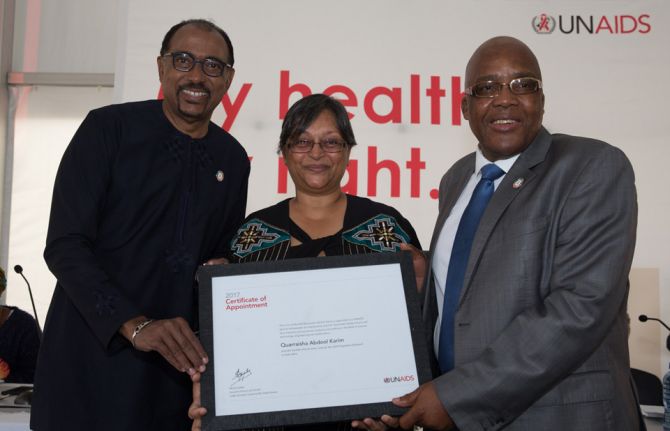
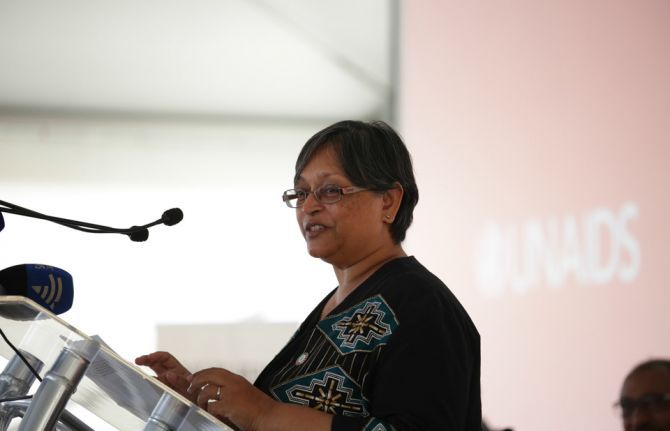
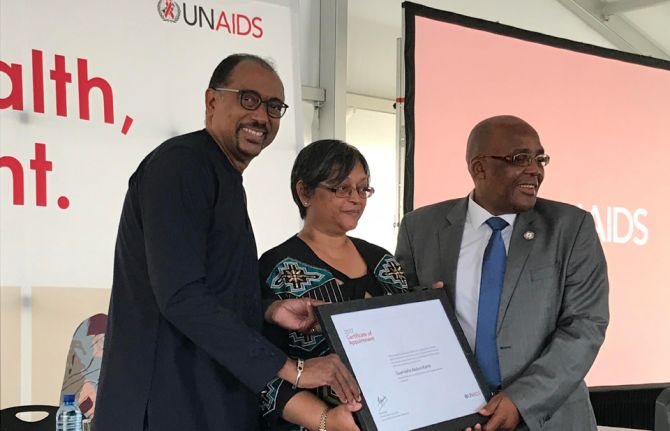
Press Release
UNAIDS Executive Director appoints Professor Quarraisha Abdool Karim as a UNAIDS Special Ambassador
20 November 2017 20 November 2017CAPE TOWN/GENEVA, 20 November 2017—The Executive Director of UNAIDS, Michel Sidibé, has appointed the Associate Scientific Director of the Centre for the AIDS Programme of Research in South Africa, Quarraisha Abdool Karim, as a UNAIDS Special Ambassador for Adolescents and HIV. The announcement was made in Cape Town during the launch of a new UNAIDS report, Right to health.
Professor Abdool Karim is one of the world’s leading AIDS researchers. She has made pioneering contributions to understanding the HIV epidemic among young people, especially among young women, and is a strong advocate for the rights of people living with and affected by HIV. In her new role as a UNAIDS Special Ambassador, she will focus on adolescents and HIV, while also championing the involvement of young women in science.
“I am delighted that Quarraisha Abdool Karim has accepted this position,” said Mr Sidibé. “A strong and consistent champion of young people living with and affected by HIV, she will use her new role to continue to translate scientific research and knowledge into people-centred solutions and prevention programmes to reduce the factors making young people so vulnerable to HIV infection. UNAIDS looks forward to supporting her work.”
Young people are particularly vulnerable to HIV. There were an estimated 610 000 new HIV infections among young people aged 15 to 24 in 2016, with young women accounting for 59% of new infections among this age group. In eastern and southern Africa, young women aged 15 to 24 years make up two thirds of new HIV infections among this age group.
“As we increase our understanding of the HIV epidemic and the transmission dynamics that place young people at higher risk of infection, all sectors of society must work together to make sure that adolescents have access to the information and services that can keep them safe and well through a crucial period of their lives and into adulthood,” said Professor Abdool Karim.
Professor Abdool Karim is Professor in Clinical Epidemiology at the Mailman School of Public Health, Columbia University, United States of America, and an Honorary Professor in Public Health at the Nelson R. Mandela School of Medicine, University of KwaZulu-Natal, South Africa. She is a member of the UNAIDS Scientific Expert Panel and Scientific Adviser to the Executive Director of UNAIDS.
In 2013, Professor Abdool Karim was awarded South Africa’s highest honour, the Order of Mapungubwe, for her contribution to the response to HIV.
UNAIDS
The Joint United Nations Programme on HIV/AIDS (UNAIDS) leads and inspires the world to achieve its shared vision of zero new HIV infections, zero discrimination and zero AIDS-related deaths. UNAIDS unites the efforts of 11 UN organizations—UNHCR, UNICEF, WFP, UNDP, UNFPA, UNODC, UN Women, ILO, UNESCO, WHO and the World Bank—and works closely with global and national partners towards ending the AIDS epidemic by 2030 as part of the Sustainable Development Goals. Learn more at unaids.org and connect with us on Facebook, Twitter, Instagram and YouTube.
Press centre
Download the printable version (PDF)

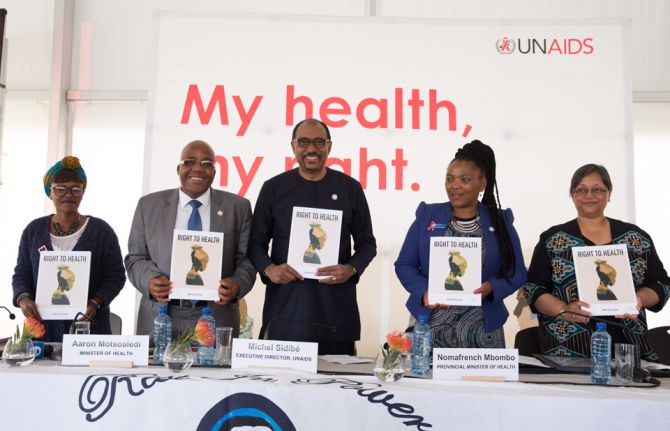
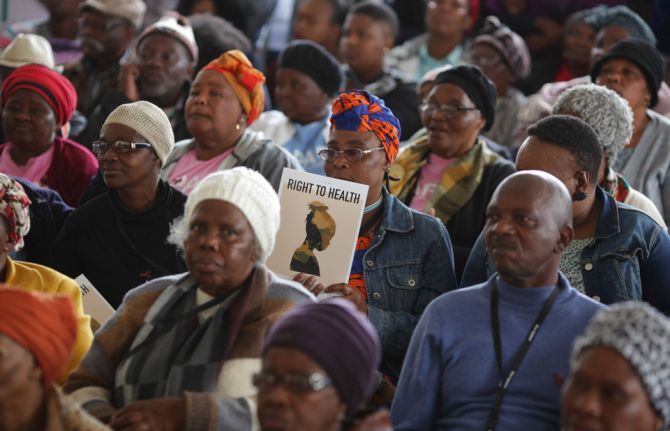
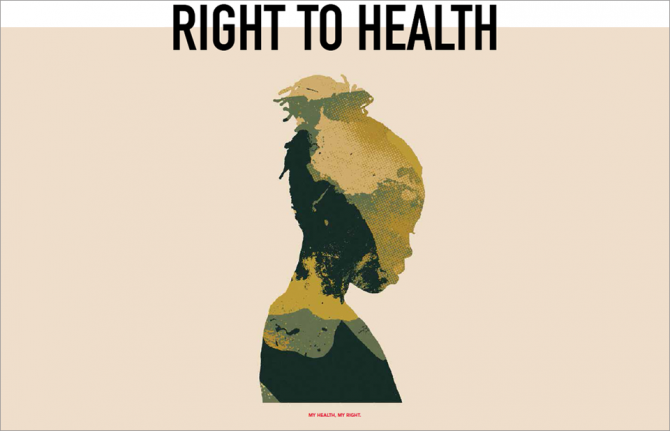
Press Release
UNAIDS announces nearly 21 million people living with HIV now on treatment
20 November 2017 20 November 2017New report from UNAIDS highlights the right to health as the key to ending AIDS
CAPE TOWN/GENEVA, 20 November 2017—Remarkable progress is being made on HIV treatment. Ahead of World AIDS Day, UNAIDS has launched a new report showing that access to treatment has risen significantly. In 2000, just 685 000 people living with HIV had access to antiretroviral therapy. By June 2017, around 20.9 million people had access to the life-saving medicines. Such a dramatic scale-up could not have happened without the courage and determination of people living with HIV demanding and claiming their rights, backed up by steady, strong leadership and financial commitment.
“Many people do not remember that in 2000 there were only 90 people in South Africa on treatment,” said Michel Sidibé, Executive Director of UNAIDS, speaking in Khayelitsha, South Africa. “Today, South Africa has the biggest life-saving treatment programme in the world, with more than 4 million people on treatment. This is the kind of acceleration we need to encourage, sustain and replicate.”
The rise in the number of people on treatment is keeping more people living with HIV alive and well. Scientific research has also shown that a person living with HIV who is adhering to an effective regime of antiretroviral therapy is up to 97% less likely to transmit HIV. As treatment access has been scaled up for pregnant women living with HIV, new HIV infections among children have been rapidly reduced. From 2010 to 2016, new HIV infections among children were reduced by 56% in eastern and southern Africa, the region most affected by HIV, and by 47% globally.
“In 2001, the first person in Khayelitsha started HIV treatment. Today, there are almost 42 000 people on treatment here. The success of Khayelitsha’s treatment programme is a microcosm of the massive success of South Africa’s HIV programme,” said Aaron Motsoaledi, Minister of Health, South Africa.
The challenges now are to ensure that the 15.8 million people in need of treatment—based on the number of people living with HIV at the end of 2016—can access the medicines and to put HIV prevention back at the top of public health programming, particularly in the countries in which new HIV infections are rising.
The new report from UNAIDS, Right to health, highlights that the people most marginalized in society and most affected by HIV are still facing major challenges in accessing the health and social services they urgently need. However, the report also gives innovative examples of how marginalized communities are responding.
In India, for example, a collective of sex workers has trained sex workers to work as nursing assistants, providing stigma-free health services to sex workers and the wider community. In Uganda, groups of grandmothers are weaving and selling traditional baskets to allow them to pay for schooling for the grandchildren in their care who lost their parents to AIDS.
In 2016, around 1.8 million people were newly infected with HIV, a 39% decrease from the 3 million who became newly infected at the peak of the epidemic in the late 1990s. In sub-Saharan Africa, new HIV infections have fallen by 48% since 2000.
However, new HIV infections are rising at a rapid pace in countries that have not expanded health and HIV services to the areas and the populations where they are most effective. In eastern Europe and central Asia, for example, new HIV infections have risen by 60% since 2010 and AIDS-related deaths by 27%.
References to the right to health are found in international and regional laws, treaties, United Nations declarations and national laws and constitutions across the globe. The right to health is defined in Article 12 of the International Covenant on Economic, Social and Cultural Rights as the right of everyone to the enjoyment of the highest attainable standard of physical and mental health. This includes the right of everyone, including people living with and affected by HIV, to the prevention and treatment of ill health, to make decisions about one’s own health and to be treated with respect and dignity and without discrimination.
UNAIDS’ Right to health report makes it clear that states have basic human rights obligations to respect, protect and fulfil the right to health.
The report gives voice to the communities most affected by HIV—including people living with HIV, sex workers, people who use drugs, gay men and other men who have sex with men and young people—on what the right to health means to them.
“Almost 20 years ago, the struggle was about access to treatment. Now, my struggle is not only about access but about ensuring that I have the support that I need to live a healthy and positive life. That is my right to health,” said Cindy Mguye, civil society representative.
Wherever the right to health is compromised, HIV spreads. In sub-Saharan Africa, for example, 67% of new HIV infections among young people are among young women and girls aged between 15 and 24 years. Studies have shown that a large number of young women and girls in the region contract HIV from older men, demonstrating multiple concerns about the ability of young women and girls to negotiate safer sex, stay in education and access age-appropriate sexual and reproductive health services.
Studies have also shown the difficulties health services face in reaching men with HIV testing and treatment, as well as broader health services, showing the challenge in encouraging men to exercise their right to health. In 2016, men in sub-Saharan Africa were 18% less likely to be accessing treatment and 8% more likely to die from AIDS-related illnesses than women.
The Right to health gives a clear demonstration of the challenges ahead in efforts to end the AIDS epidemic as a public health threat by 2030, as outlined in the 2016 United Nations Political Declaration on Ending AIDS.
The report underscores that to reduce new HIV infections and AIDS-related deaths and ensure access to essential health services, funding for health needs to increase. It gives examples of how to enhance funding, including increasing the share of health spending as a proportion of national economies, making savings through efficiencies and partnering with the private sector. The funding gap for HIV is estimated at US$ 7 billion by 2020.
UNAIDS has set an agenda to Fast-Track the response to HIV by 2020 towards ending the AIDS epidemic as a public health threat by 2030. It will continue to work closely with its Cosponsors and partners to ensure that everyone, everywhere can fulfil their right to health and can access the health and social services they need.
In 2016 (*June 2017) an estimated:
*20.9 million [18.4 million–21.7 million] people were accessing antiretroviral therapy (in June 2017)
36.7 million [30.8 million–42.9 million] people globally were living with HIV
1.8 million [1.6 million–2.1 million] people became newly infected with HIV
1.0 million [830 000–1.2 million] people died from AIDS-related illnesses
UNAIDS
The Joint United Nations Programme on HIV/AIDS (UNAIDS) leads and inspires the world to achieve its shared vision of zero new HIV infections, zero discrimination and zero AIDS-related deaths. UNAIDS unites the efforts of 11 UN organizations—UNHCR, UNICEF, WFP, UNDP, UNFPA, UNODC, UN Women, ILO, UNESCO, WHO and the World Bank—and works closely with global and national partners towards ending the AIDS epidemic by 2030 as part of the Sustainable Development Goals. Learn more at unaids.org and connect with us on Facebook, Twitter, Instagram and YouTube.
Contact
UNAIDS South AfricaNatalie Ridgard
tel. +27 82 909 2637
ridgardn@unaids.org
UNAIDS Communications
tel. +41 22 791 3873
communications@unaids.org
Related publications
Press centre
Download the printable version (PDF)
